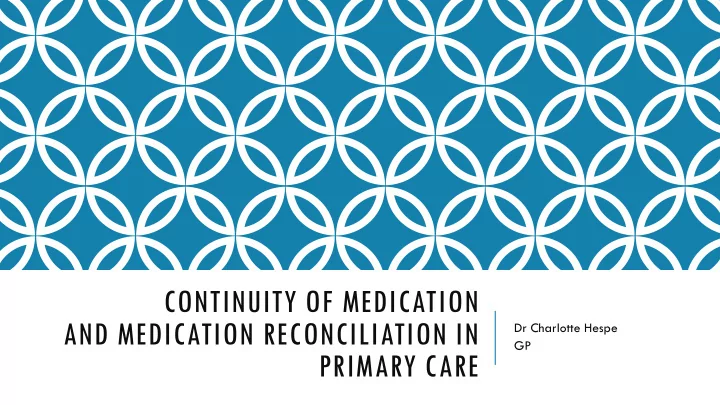

CONTINUITY OF MEDICATION AND MEDICATION RECONCILIATION IN Dr Charlotte Hespe GP PRIMARY CARE
TRIPLE AIM FOR PRIMARY HEALTHCARE Improving the patient experience of care (including quality and satisfaction) Improving the health of populations Reducing the per capita cost of health care
PRIMARY CARE SERVICE DELIVERY Patient centred: Preventive care Acute care, exacerbation / presentation Chronic disease / multimorbidity care Palliative care
PATIENT CENTRED MEDICAL HOME Comprehensive care 5 Universal features • Patient-centred • Comprehensive Patient Coordinated centred care • Coordinated PCMH • Accessible • Committed to quality and safety Committed to quality Accessible and safety
Comprehensiveness Template of the and care Continuity of care future coordination 7. 10. 9. Patient-team Prompt access to Population care management Partnership 8. 6. 5. Data driven Team based care Registration improvement 4. 3. 2. Engaged leadership 10 Building Blocks for quality patient centred Primary care 1.
IMPROVING QUALITY OF HEALTHCARE 1. Increased delivery of patient centred quality primary care 2. Achieve accurate Electronic health records with accessibility of high level data 3. Improved interoperability of IT systems across the health system 4. Achieve increased levels of Health Literacy
CASE STUDY 1 Mrs B, aged 86. Gold card. Lives at home (alone but supported by family members on a rostered basis) Current Diagnoses: CCF, IHD, Prosthetic mitral valve, AF, Severe Renal Impairment, Osteoarthritis, Osteoporosis, severe GORD, recurrent severe UTI (cause acute delirium), previous Pagets disease, Vertigo (of unknown origin),bilateral glaucoma and dry eye syndrome. “Team” includes: GP , Practice Nurse, 6 Specialists (Cardiologist x 2, Renal Physician, Gastroenterologist, Ophthalmologist, Rheumatologist), 3 Allied Health specialists (OT, Physiotherapist, Podiatrist), Pharmacist for Webster pack Multiple medications including Warfarin , high dose Omeprazole and ranitidine, Digoxin , Metoprolol, Paracetamol, Prochlorperazine, multiple eye drops (Latanoprost and lubricating gels and drops). Requires weekly INR checks Multiple allergies including to Sulfa and Penicillin Over last 18 months has had 14 admissions to local tertiary hospital due to chest pain, UTI, headaches and unstable BP , severe nausea and vertigo. Problems: Differing information re Digoxin dose Warfarin monitoring and variable dose Metoprolol Antibiotics
SYSTEMS Atul Gawande (TED2012 http://www.ted.com/talks/atul_gawande_how_do_we_heal_medicine) “Making systems work is the great task of my generation of physicians and scientists. But I would go further, and say that making systems work — whether in healthcare, education, climate change, making a pathway out of poverty — is the great task of our generation as a whole.”
SYSTEMS- CLINICAL MICROSYSTEMS A small functional front-line unit that provides Healthcare The microsystem includes the people who work together, the defined environment in which they work, the individuals who receive the care, the processes and activities needed to accomplish the work and the Information and IT that supports the work.
CASE 2 Mrs N, 63 yo Married, lives in apartment with husband Chronic Low back, hip, neck, shoulder pain (multiple cause but started in 1994) Laminectomy in late 90’s : Neurosurgeon still overseeing care. Recommended surgery for ongoing pain management. Second opinion from Orthopaedic surgeon x 2 : Hip surgery not recommended Major depression / Anxiety : Psychiatrist oversees therapy and prescribes SNRI, benzodiazepines x 2 (also known to drink excess ETOH in the evenings) Underwent double laminectomy – complicated procedure/ pain +++ post surgery/ 2 week admission – discharged to Rehabilitation hospital for 2 weeks. Ongoing severe pain 8/10 Sent to GP for scripts for pain management on discharge home from Rehab No formal discharge letter from initial hospital / Nurse discharge letter from Rehab. Medications that patient verbally reported: Endone, Oxycontin SR, Panadeine Forte, Panadol Osteo, Pregabalin, Sertraline, Diazepam, Alprazolam, Temazepam
MEDICATION RECONCILIATION IN PRIMARY CARE Patient Electronic Discharge letter (timely and hopefully accurate ) -information not always accurate (e.g. if transferred to multiple wards and ICU during admission then medication changes may have been lost in transfer) Specialist letters Community Pharmacy Home visit / Health Assessment / Home Medication Review (partner with Pharmacist) Family members Hospital- talk to RMO or Medical records department (can be tricky as they will need patient consent) Specialist rooms / mobile
INTEGRATED CARE AND INTEROPERABILITY OF DATA
SHARED ELECTRONIC HEALTH RECORD Key features for useful sharing of electronic health records: 1. ACCURATE UP TO DATE DATA (patient demographics, allergies, vaccinations, past medical history, current medications) (Data Cleansing, Data Cleansing, Data Cleansing) 2. Practice policies that ensure the organisation's use of the e-health record system is secure, responsible and accountable 3. Implement RACGP Computer and information security standards (CISS): www.racgp.org.au/ehealth/security 4. Use coded IHI (from the Health Identifiers Service at Medicare) Encourage and teach “health neighbourhood” to join in
HEALTH LITERACY “ the ability to obtain, read, understand and use healthcare information to make appropriate health decisions and follow instructions for treatment” Low health literacy reduces the success of treatment and increases the risk of medical error: up to half of patients cannot understand basic healthcare information
ANY QUESTIONS?
Recommend
More recommend